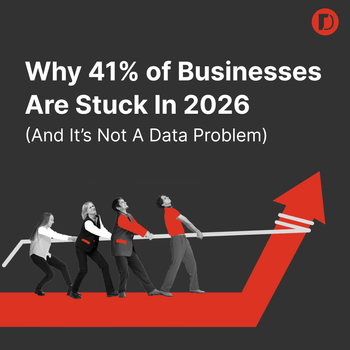Marketing Plan Examples & Samples for Business Scaling
by Cydney Hatch • March 19, 2020
Marketing is an essential part of any successful business strategy. It has everything to do with identifying and reaching objectives for your business sales, publicity and growth.
What if, for example, your business was to locate, catalog and find homes for archeological treasures?
Indiana Jones was a master planner in that business space. He conducted extensive research, put together his gear, assembled his teams, and then went out to kick butt and find archeological treasures! Then, afterwards, he improvised and pivoted as needed 😉
The bigger the mission, the more funding, planning and field contacts he used. It makes you think of your marketing plan in a more exciting light, am I right?
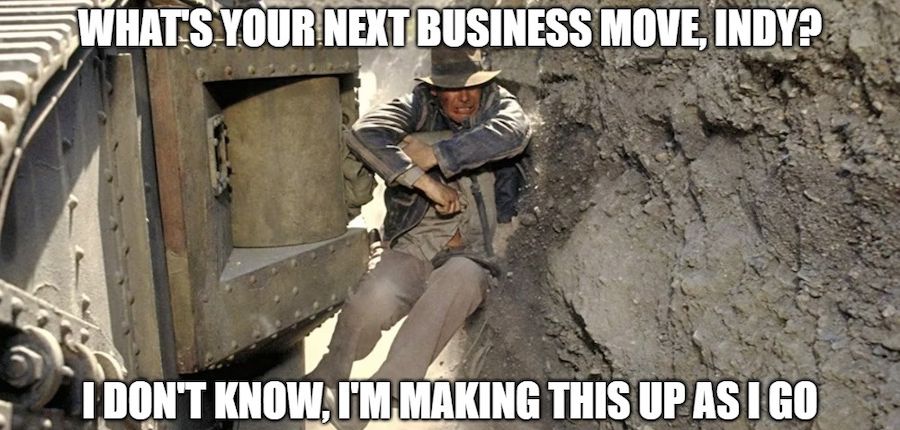
It might seem like a stretch, but just like Indiana Jones, you need to map out your marketing plan so you can try to avoid having to “make it up as you go.” You can see your marketing plan as a comprehensive document that outlines the marketing strategy, tactics, and activities that your business will undertake to achieve its marketing objectives. Also, as your business grows, so too will the strategies, channels and budgets you might need.
There are plenty of examples of marketing plans that you can use as templates for your own, and we will include some of those here.
Remember that a well-crafted marketing plan can help businesses to identify their target audience, determine the best way to reach them, and allocate resources effectively. There might not be one single marketing plan that captures what you want to include, so remember that you can customize any marketing plan to your own business, including what is more important to you.
In this blog post, we will explore what a marketing plan is and provide some examples of marketing plans. I’m also going to walk you through the steps I used to create a made-up business called “Free People Coffee & Bar.” So grab your hat, your whip and your cargo pants for some intense marketing plan discoveries!
MARKETING PLAN EXAMPLES IN ACTION
Before we officially start on what a marketing plan is and how to create one, let’s look at a couple of marketing plan examples that worked well!
MARKETING PLAN EXAMPLE: COCA-COLA “SHARE A COKE” CAMPAIGN
Most of us are aware of the highly popular Coca-Cola “Share a Coke” marketing campaign. That is when, in 2014, you started seeing popular names pop up on Coke cans everywhere. The campaign was designed to encourage consumers to buy Coke products to share with friends and family and sparked a social media frenzy as people searched for bottles with their names on them.
What made this campaign work?
- Personalization: By including popular first names on the bottles and cans, Coca-Cola was able to make the product feel more personal and increase consumer engagement.
- Social media: The campaign encouraged people to share pictures of their personalized Coke bottles on social media, creating buzz and driving further engagement.
- Emotional appeal: The campaign’s message of sharing a Coke with loved ones tapped into consumers’ emotions and helped to build a sense of community around the brand.
MARKETING PLAN EXAMPLE: MARRIOTT INFLUENCE MARKETING CAMPAIGN
One great example of a marketing plan that includes utilizing an online influencer is the Marriott “Millionth Mobile Check-In” sweepstakes. For that campaign, Marriott wanted to raise awareness and use of their app for mobile check-ins. They partnered with What’s Trending founder and host, Shira Lazar, and Jeana Smith, founder of Prank vs. Prank, to give the millionth mobile check-in guest a day they would never forget.
To celebrate the millionth customer to check-in to their hotels using the mobile app, Marriott surprised couple, Hunter and Tina Swift, in Los Angeles with balloons, music, and more.
They launched their marketing plan with a sweepstakes to win prizes when you check-in with the app and ended it with this huge event complete with a DJ, bellhop acrobats, dancers, and the gift of one million Marriott Rewards points to the happy couple.

This not only raised brand awareness but drove engagement as visitors were prompted to use the app and enter the sweepstakes. Making it legit by throwing the huge party just made Marriott even cooler.
What made this campaign successful?
- Plan ahead: Marriott knew that it was important to be tracking mobile app check-ins to their hotel chain. This allowed them to know when the millionth check-in was approaching and how to prepare.
- Customer research: They understood their customer base to know how to celebrate the millionth check-in and how to excite other customers to take action in downloading the app to use it for check-ins moving forward.
- Multi-channel messaging: Marriott used different channels to push the video out for the millionth check-in celebration. Doing so created interest on these different channels where they knew they’d get recognition and customer interest.
WHAT IS A MARKETING PLAN & HOW TO MAKE ONE
A marketing plan is a plan of action compiled into organized documents. It takes the essentials of the business and incorporates them into messaging, advertising, outreach, and other initiatives. A marketing campaign cannot be successful without a marketing plan in place.
That means, if you don’t have a marketing plan, you’re basically shooting in the dark. Be the marketer with a plan by starting off with what I’ve crafted. These are the essentials for how to craft a marketing plan.
EXECUTIVE SUMMARY
One of the first parts of a marketing plan is the “Executive Summary.” It may seem a little boring, but it provides clear, compact statements about what each section of your marketing plan will be about. This can be bullet points with descriptions, or a paragraph-style explanation of your plan and what is in it:

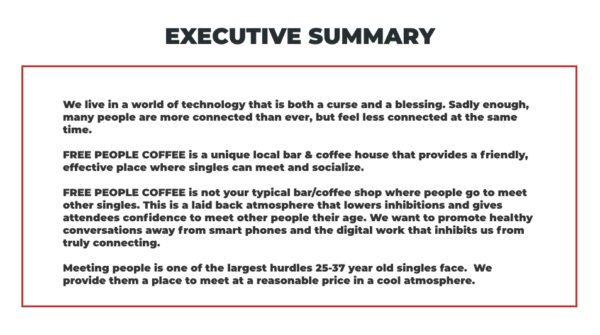
PRODUCTS AND SERVICES
Next, you will want to list the many values that you bring to your potential customers—whether it’s products, services or experience. In my marketing plan sample, I wanted to think about how my products and atmosphere helped my potential customers have a different kind of social and dating scene.
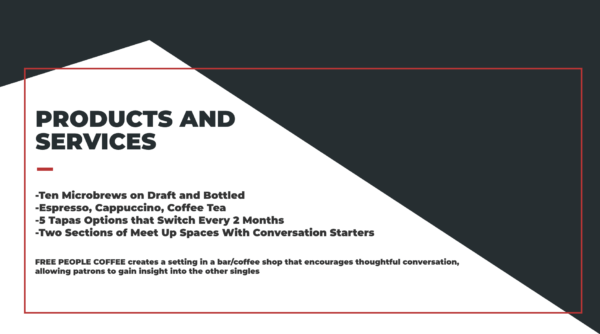
I will be offering quality beverages and small food items as well as social-topic activities that allow people to meet in a different kind of way. This structure made popular from the game, VERTELLIS, will allow our potential customers to have a meaningful conversation with new people. In comparison to other bars, ours will allow singles to have a different type of experience to meet and talk to other singles in a softer-music, nicely-lit, socially-focused place.
VISION AND MISSION STATEMENTS
This is an important place for you to summarize and really hyper-focus what your business will change, do, or offer potential customers.
What is your business value proposition (aka a unique selling proposition – UVP)?
Without a value proposition, there is no reason for people to patronize your business. You should be able to convey in a couple of sentences, what you have to offer and why it is the best.
When you are thinking about your value proposition, be sure to ask yourself whether you have the appropriate infrastructure and resources in place to deliver on your promised value. Pro tip: You should always keep a little space in the back of your mind about how each of these marketing plan pieces will be affected by eventual growth, as well.
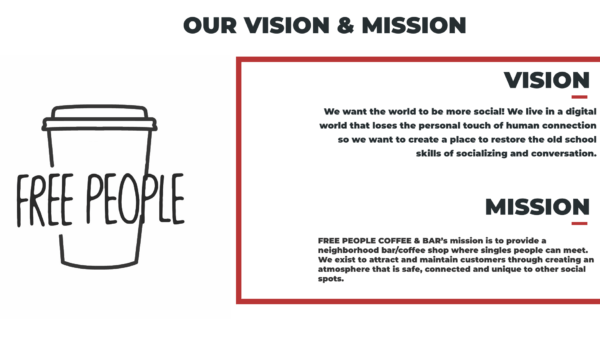
In my example, we specifically state our desire/vision to make our community more social. Our vision is to create a place where people can come to have a conversation and a place to facilitate that conversation.
The mission goes further into that statement by answering HOW we will do that. We will create a community bar and coffee shop that potential customers can come and enjoy a different type of bar scene.
No more loud bars, dark rooms and shallow relationship building. FREE PEOPLE allows people to be human, connect and focus on experience supplemented with beverages and food. Like this, you need to think of a vision of WHAT and then move to the mission statement of HOW.
RESEARCH AND ANALYSIS
In this section, you’ll want to report on a variety of market-related things that have an impact on your overall marketing plan. This is the nitty-gritty stuff that can indicate where you stand and offer the exact insights you need in order to market and scale just the right way. The following are part of what you should include:
COMPETITION
Research your competitors and analyze the following:
- Product attributes
- Pricing
- Marketing and promotion strategies
- Distribution channel and method
- Products or services offered
Yes, you’re “spying,” but make no mistake, they are or will be spying on you too.
Take note of what they are doing right–how they are getting in front of their audience, and improve upon those tactics. This will also help you find ways to set yourself apart and create a unique place for yourself in that market space.
In my example marketing plan, FREE PEOPLE, I was able to research some of the hottest bars in the San Francisco area as well as single adult organizations that facilitate meetups.
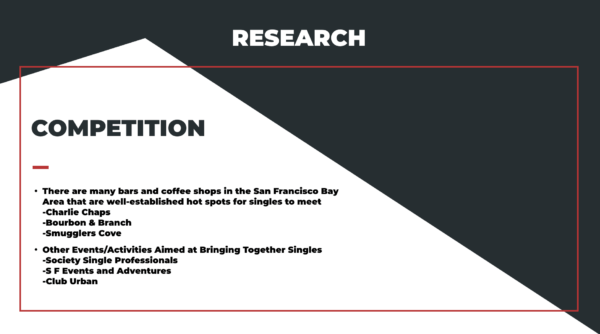
In your research, look for ways that your competitors keep people coming back for more. For Charlie Chaps, I could see that they are a great stand-up bar that has a lot of hot and funny talent coming in every week. For Bourbon and Branch, it is high-quality drinks at a reasonable price with a fantastic view of the city. You too can find patterns, methods and strategies your competition is doing and shape them to your own business.
Ask yourself the following questions:
- Who are the types of people I want to target?
- What keeps them coming back for more?
- What targeting factors do they have that create interests?
- What are their price points?
- What are their connections?
- How do my competitors advertise to and connect with the community I want to target?
When you have your competition figured out, you can anticipate their moves, improve on their moves, and find a creative edge over them. Staying ahead of his competitors was probably Indiana Jones’s number one concern.
COMPETITIVE ADVANTAGE
So, considering the above competition analysis, my coffee and bar house can offer a place for people to meet in a comfortable, person-meeting environment that young people today want and need. The basic market need is a place where singles can meet new, like-minded people.
FREE PEOPLE uses a conversation system to enhance and facilitate singles meeting each other instead of getting muffled through simple bar scene tactics of dark rooms, loud music and structure not conducive to talking and meeting. We will also offer social community conversations where those who are politically, religiously or personally active can come and have community group discussions with local leaders.
We also offer people products they can take home to promote our social structure outside of our facility. We create question packs that allow buying customers to take this social structure we promote to their homes.
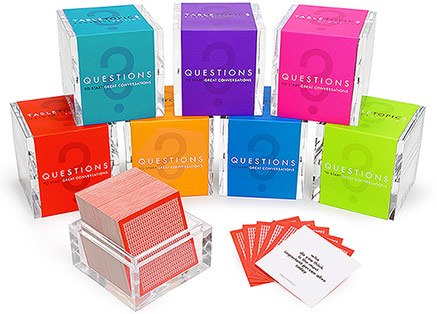
As a community coffee and bar house, it is our job to make our community a better place and to feel more connected. Collectively we offer:
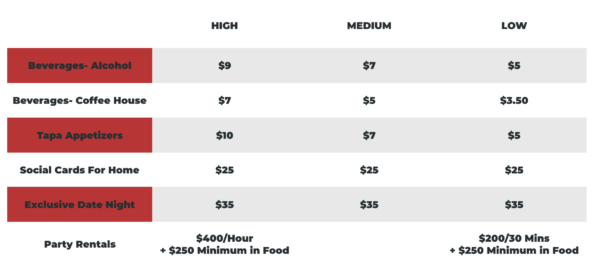
- Food quality: The preference for higher-quality ingredients is being reinforced as consumers have more and more options for food all the time. We keep it simple and always changing to maintain interest. We have also found a price point that is competitive with our competitors.
- Quality conversation: Customers recognize that intellectual conversations can be had in bar settings and would prefer this over normal bar talk. They would also appreciate ways to take this experience home with products they can purchase.
- Access to meeting people: People are tired of being single and are looking for ways to meet like-minded individuals.
By offering not only a place and product but a social change within how we meet others, we can improve the happiness of our potential customers and community. We stand out as a different kind of place where people can be human and connect.
S.W.O.T
The S.W.O.T. model falls under the research and analysis section of your marketing plan, but it deserves special attention. It stands for: Strengths, Weakness, Opportunities, and Threats. Again, using this acronym in your research and analysis can help you cut out a unique edge and differentiate yourself from your competition. Let’s get into this a little deeper…
STRENGTHS
When looking at your business strengths you want to list realistic advantages, strengths and positives you bring to the table. When you think about your value proposition this should come easy.
In my marketing plan sample, FREE PEOPLE speaks to the personal and emotional needs young single adults need in their lives: connection and interaction.
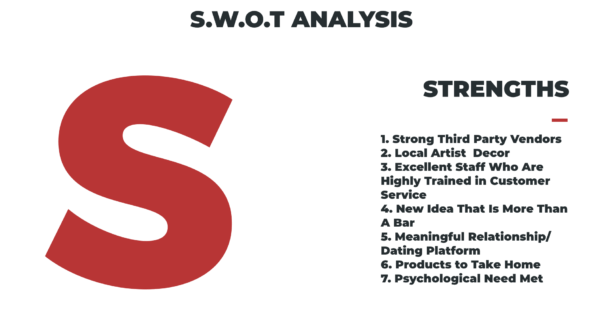
We as a bar and coffee house have strong third-party vendors that give us quality products to make our beverages and appetizers. With great culinary experiences, we have local artists that help us create an aesthetic that promotes creativity, positivity and change. We also have high-quality staff that promotes healthy relationship building and great customer service.
From a business standpoint, we bring new ideas to the bar and social scene that promotes different types of connections that other bars do not. We promote personal conversations, invite meaningful community conversation events with the help of local leaders.
WEAKNESSES
When looking at business weaknesses, consider your competition and what you might lack, compared to them. Don’t be too hard on yourself, but do be honest with yourself. You can’t grow if you can’t see how you need to improve. When you take a look at weaknesses, this also helps you plan out ways to address and improve your business message.
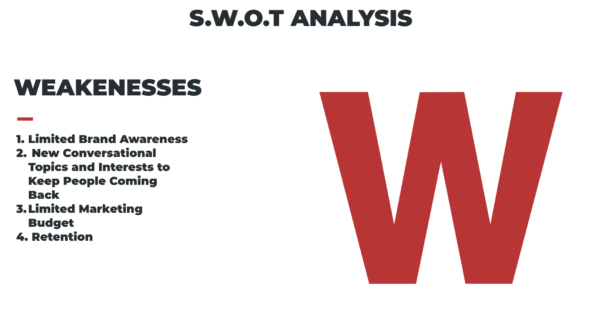
So, in my example, as a new coffee and bar house, we are obviously not as established as some of the known “hot spots” of the city. With that in mind, it also means we do not have as much of an income yet as compared to others for marketing and getting our name out there. This will require us to reach out and try to get influencer endorsement and other free promotions through local news, etc. This will help us draft our content to try and set us up as new, exciting and something to experience.
OPPORTUNITIES
I always love this part of a SWOT analysis because it is all about growth. Here, look for ways you can and will succeed as a business. Look at your market and how it is projected to grow and how that will benefit your business. Look for ways you can undercut and improve what your competition is doing!
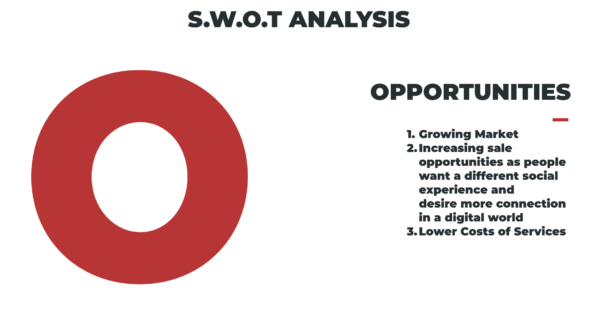
In my example, FREE PEOPLE has a good market to bank on as there are always single people. In fact, San Francisco was named the best city for singles in 2017. With that knowledge, we can monopolize on the sale and other opportunities to reach an ever-growing market of individuals.
THREATS
If our friend, Indy, didn’t anticipate some threats and difficulties, he wouldn’t be adequately prepared to deal with them. The same is true of everything. Don’t produce a negative effect by dwelling on it or expecting it, but certainly know all that you can about possible threats to your business health. What are the realistic limitations you face? Look for things that will affect your bottom line, limit your target audience, or that will present local problems if not addressed.
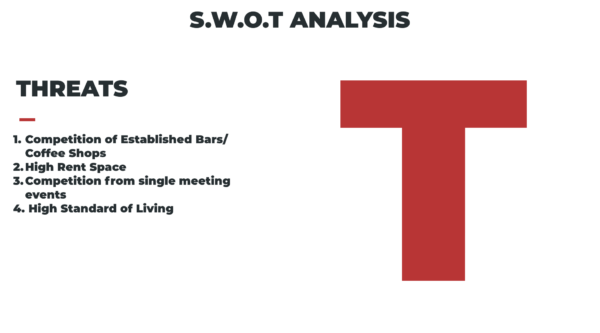
In my sample marketing plan, FREE PEOPLE, has to compete with the existing bars people know and love. It is our job to write content, advertise and communicate with the community about how our bar and coffee shop is a different and better type of experience.
When considering threats other than our competition, we need to look at our target audience. Since we are a bar in one of the most expensive places in the United States, that might put a limitation on the younger end of our demographics to enjoy our services and products. Not to mention, our bottom line is affected because of the expense of operating in that locale.
CUSTOMER INFORMATION: AUDIENCE, PERSONA AND LIFECYCLE
The next major part of your marketing plan is your customer base. Who are you targeting? What are their passions, problems and pain points? What are the different types of customers that are worth your time?
In our example, FREE PEOPLE, we target young single adults ages 25-37, particularly women and socially active adults.
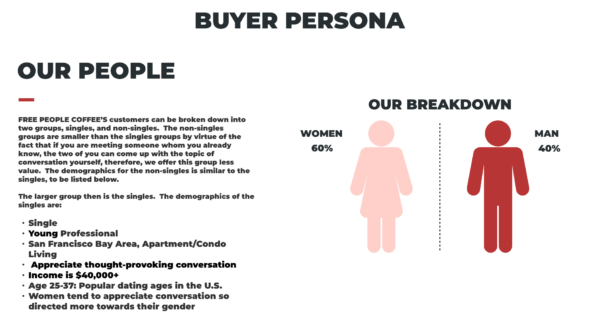
- Single
- Young Professional
- San Francisco Bay Area, Apartment/Condo Living
- Income $40,000+
BUYER PERSONA PROFILE INFORMATION
- Values: Human connection, promoting positive social change, education, long-term dating
- Problems: Has a hard time meeting like-minded and similar-aged people, busy work schedules, wants long-term relationships, sick of the same old bar scenes, wants to create positive social change in communities
- Interests: News and current events, socializing, arts and experiences, communication, gym, healthy lifestyle, Instagram and Facebook, traveling, education, dating sites and services, reading, religion and social issues
Once you know your customers you can now look at how best to reach them through meaningful marketing objectives.
WHAT YOU NEED TO DO NEXT
To dive into your marketing strategy, you need to start by knowing what you want to get out of it. Up to this point, you’ve done some research and you know who your competition is, but what do you really want to achieve with this marketing strategy… in essence, what is a marketing plan to you?
MARKETING OBJECTIVES
Marketing objectives are a brand’s defined goals. They outline the intentions of the marketing team, specific numbers and provide clear actions to execute.
Do not rush or focus on execution before you define what success looks like for your business.
For example, here are a few possible goals you might have:
- Introduce # of new products
- Target a new customer persona
- Extend/regain market
- Build brand awareness
- Develop brand loyalty
- Grow market shares
- Build industry authority
- Boost sales
- Enter into long-term contracts
- Improve delivery and customer service
- Increase brand exposure and engagement on X
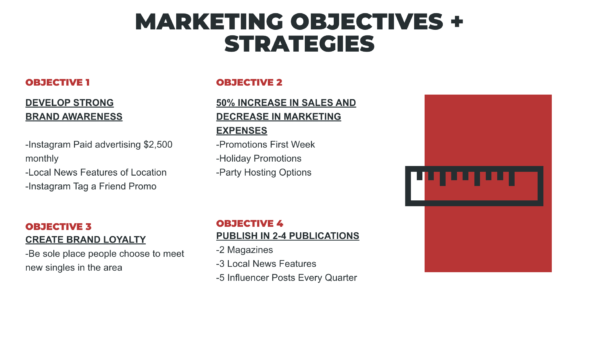
These objectives are fairly broad, but you can get as specific as you need to. As a marketer, it is your job to figure out how to use marketing tactics to achieve these goals! Most plans call for money… so your budget is next up.
CREATE A PROGRESSIVE MARKETING BUDGET
- Focus on what historically worked
- Use tactics that allow full control/customizability
- Don’t scale until you prove ROI
- Cross-channel to double dip
By following proven success tactics and being smart with your marketing budget, you can make money stretch further. Don’t splurge because you want to get things up and running. Plan and patiently execute–you will be grateful you did!
So, for our example with FREE PEOPLE Coffee and Bar, I calculated that the business will need to make at least $40,500 a month in revenue to reach the break-even point.
The first two months will be used to set up the physical location, hire personnel, establish vendor relationships and obtain an alcohol license. The third month will be the grand opening. Business during the second month will be understandably slow as a steady customer base takes time to build. This is the stage where the majority of our marketing budget will go.
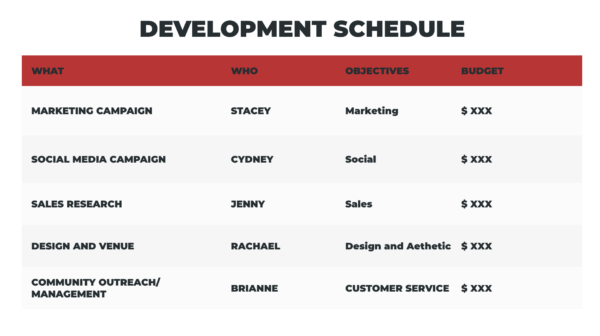
When you create a tentative financial forecast, you will then need to carefully assign people to the detailed marketing campaigns and tasks. With their detailed tasks, be sure to include deadlines, budgets and expectations.
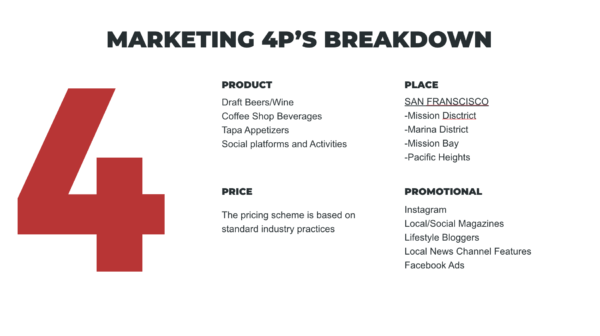
To break things down further, you will want to map out detailed plans for sales funnel content. So, if I was to brainstorm content around my market research and target customers for FREE PEOPLE:
Awareness Stage
- Guides: A Guide to Modern Conversation, Meeting Like Our Parents Did
- Blogs: 11 Ways to Meet Singles in San Francisco, Dating Statistics in the Bay Area, Say Goodbye to Dating Apps and Say Hello to ‘Old School’
Shopping/ Learning Stage
- Video: CONNECT: A FREE PEOPLE EXPERIENCE, Dating Done Right: Meet FREE PEOPLE
- Guides: How Successful Are My Tactics: Statistics on Dating Scene Tactics & Satisfaction
Decision Stage
- Business product comparisons: Advertisement for Promotional Event Night (Change The Way You Meet)
- Blog content: Why We Need to FREE PEOPLE
- Invite to social events: Bring a Friend Night, Community Talk, etc…
- Retention plan: Memberships, Discounts, Birthday Codes
Content not only attracts customers but it also provides SEO value. By creating consistent and quality content, your business blog and website will gain more traffic. Google rewards quality stuff so why not attract some organic marketing help and new customers through Google?!
From there you will also need to consider your social media use, online marketing as well as your collaboration plans with other businesses/influencers.
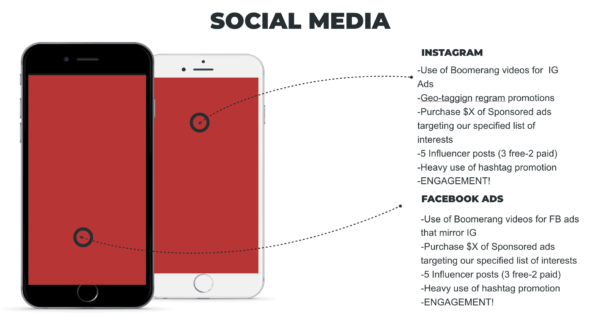
So, in FREE PEOPLE’s example, I wanted to map out specific money amounts we would put towards sponsored ads on Instagram and Facebook.
I also mapped out different types of content and creatives that work for our industry like videos, specifically boomerang. We would also want to make specific hashtags and links people can use so we can start building a network on these platforms.
When looking for influencers we wanted to work with, we would hyper-focus on ones with at least 20k followings and topics that are of interest to us. Specifically Allie.Eats would be a great example of an influencer we would want to pay or invite to experience our new bar as she focuses on bar/food scenes within the San Francisco area.
In return for her promoting our bar, we can give her free products, payment, etc, which promotes a healthy and balanced relationship that can work in the future.
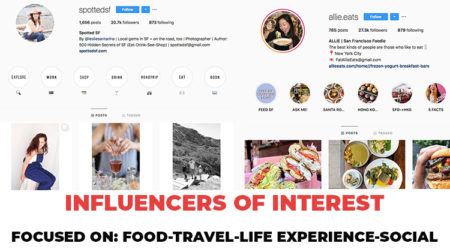
By detailing out these plans, you will be able to track your success and tweak the contracts and campaigns for results in the future. Blogs and backlinks are just a couple of the ways you can make these relationships work for you!
So, for the marketing plan sample of FREE PEOPLE, I made four marketing objectives focused on revenue and exposure. From there, it is my job as the “marketer in charge” to figure out what tactics will help make those objectives happen! I created specific money amounts, platforms and numbers involved to reach the goals we set out as a starting business.
The top priority for FREE PEOPLE’s exposure will be to communicate value to our target audience. This will be done through a variety of methods. The first method will be strategically placed advertisements.
One place that will be used for advertisements is social and local newspapers and magazines. This will be the main source of advertisements because the demographics match up between their audience and ours. We will also do advertisements on Instagram showing users who will partner us as influencers to promote us on that platform. Between paid ads and influencers, we should be able to connect our business with young, single, adult locals.
At a later time, we also want to maximize email marketing for our restaurant/bar. We have to have an agile planning strategy, though, so we can’t get too detailed right now. It’s just something to keep in mind.
Another source of marketing will be through strategic partnerships with companies like gyms that are typically full of single adults. When it came to collaboration with gyms, we were able to offer cross-promotional discounts!
The last exposure marketing tactic we will promote is a grass-roots effort with “bring-a-friend” promotions that invite more people at a reduced cost to experience our business. This tactic will eventually promote brand loyalty as we create an experience people cannot ignore.
SCALED AND MEASURED: YOU CAN ADAPT
Companies are always looking for a new edge to capture mindshare and differentiate their solution within the marketplace. By creating a strong marketing plan you can do that!
Although the above sections are things you should include in your marketing plans, every marketing plan should be fluid and reflect your values and objectives. You will need to customize and scale every plan to your needs but also make it so it’s a living document to adapt to market change.
As you are answering the question, “what is a marketing plan?” for yourself and your company, you will be able to refine your answers until your own marketing plan is ready to launch!
Hopefully, this article and the marketing plan examples in it helped ease your mind and inspire you about how to put your marketing plan together. But if you are still feeling overwhelmed, reach out, we would love to talk!
What do you consider when scaling a marketing plan sample? What are the bigger concerns of templates and using them for different types and sizes of businesses?




